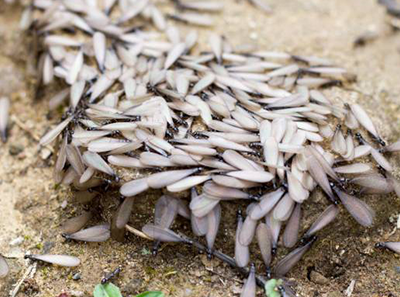
Have you started seeing flying insects pop up around your home? They might be flying termites. And the best ways you can get rid of them is with at-home methods and professional extermination. Solutions like fixing leaky plumbing and moving firewood and mulch are good general practices – but if you want to be free of termites (including the flying kind), you need the experts to inspect your home and execute termite extermination methods.
Once spring rolls around, termites start swarming to find new homes and food and water sources all over Mid-South TN. As the most destructive pests in the country, termites are a widely feared invader, and the sight of flying termites around your home is only either bad news or worse news. Read on to learn from the experts at Inman-Murphy, Inc. to learn how to get rid of these destructive pests.
How You Can Get Rid of Flying Termites
If you have swarmers visiting your home and are looking to prevent a full-blown infestation, there are a few things you can do:
- Store your firewood away off of the ground and as far away from your home as you can.
- Move mulch away from the foundation of your home.
- Make sure your drainage systems are directing water away from your home and especially away from your foundation.
- Ensure that there are no leaky pipes or other water fixtures in and around your home.
Taking these preventative measures will make it harder for termite swarmers to establish a colony in your home by blocking off easy access to food sources through damp wood. However, if you see termite swarmers in your home, you should also look around for damaged and sagging wood from termite damage. Winged termites could be a sign of a serious infestation.
What Are Flying Termites?
Termites with wings are often called alates or swarmers. They are reproductive termites whose responsibility is to grow and spread their colony. Because they appear similar to some of the flying ants in our region, it’s important to be able to identify them so they can act quickly when they show up. Here are the main differences between flying termites vs flying ants:
- Termites swarmers have a set of two equal-sized wings. Ants have large forewings and smaller hind wings.
- Flying termites are most often lighter in color than flying ants.
- Ants have a pinched, slender waist, while termites are more broad and rounded.
If you find flying termites around your home, it could mean one of two things. Either some new termites are scoping out the premises, or you have an undetected termite infestation that’s large enough to spread.
Should I Worry if I See Flying Termites?
Yes, you should worry when you see flying termites – it means you likely have an active colony in or near your property. These swarmers fly around when they’re looking for a feeding source, which could be your home’s structure.
Are Winged Termites Harmful?
Termites are harmful to any wood structure or cellulose-rich material, but not to people or pets. Termites do not bite, sting, or carry any harmful diseases.
Why Do Flying Termites Suddenly Appear?
Flying termites appear when they’re searching for a new spot to expand their colony. And the best place for a termite colony to thrive is wherever there is plenty of cellulose (mostly wood).
What to Do When You See Winged Termites?
Since termites are one of the more serious infestations, you need to call a pest control company that specializes in termites immediately, like Inman-Murphy, Inc. Since it takes time for termites to establish a colony, seeing winged termites means there is at least one active colony nearby.
And if it’s safe for you to do so, we also recommend inspecting your property for any signs of termites (dropping, tunnels, damaged wood) until an expert comes by.
Termite Removal in Mid-South TN
If you find that you have an infestation on your hands, the only way to get rid of it completely is to leave the work to a professional termite exterminator. At Inman-Murphy, Inc., we equip our termite control team with an arsenal of products and strategies to eliminate even the most established termite colonies from our customers’ homes. Contact us today to learn more about how we can help you!
Back to Termite Exterminators – Control – Removal
